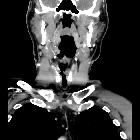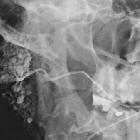Amyloidose







Amyloidosis (plural: amyloidoses) is a heterogeneous disease, or even considered a constellation of diseases, resulting in the deposition of relatively similar proteins. It has many causes and can affect any organ system.
Epidemiology
The disease may have a male predilection. It typically affects middle-aged individuals around 60 years .
Clinical presentation
In view of the vast variety of clinical forms of amyloidosis, the potential spectrum of symptoms and signs is extremely broad, and can present in almost any way.
Pathology
Amyloid comprises a group of proteins characterized by certain physical properties. There are at least 15 amyloid proteins, derived from diverse precursors. Some demonstrate the structural morphology of immunoglobulins, i.e. amyloid light chain.
Subtypes
- primary amyloidosis: associated with monoclonal plasma cell dyscrasias
- secondary amyloidosis: usually occurs secondary to a tissue destructive and inflammatory process
- hereditary amyloidosis: can be seen with familial Mediterranean fever (FMF)
- senile amyloidosis
- localized amyloidosis: sometimes classified as a separate entity with the above four accounting for the systemic forms
- dialysis-related amyloidosis: can occur with either haemodialysis or peritoneal dialysis
In certain scenarios, the amyloid proteins are produced and deposited locally, whereas in others, the protein is distributed systemically.
Systemic amyloidosis
The majority occur in the systemic form:
- AL (amyloid light chain)
- synthesized by plasma cells, and seen in conditions with monoclonal proliferation of these cells
- AA (amyloid associated)
- derived from SAA (serum amyloid A) protein which is synthesized by the liver and forms part of the HDL3 lipoproteins
- typically seen in chronic inflammatory disease or familial Mediterranean fever
- Aß2M (amyloid ß2-microglobulin)
- derived from ß2-microglobulin
- seen in patients on haemodialysis or peritoneal dialysis
- hereditary (AApoA1) (apolipoprotein)
- hereditary (AFib) (mutant fibrinogen)
- hereditary (ALys) (lysozyme)
- ATTR (amyloid transthyretin)
- seen in senile systemic amyloidosis/neuropathic cerebral angiopathy
- is the most common form of familial amyloidosis
Localized amyloidosis
Accounts for ≈15% of amyloidosis:
- A4ß2 (beta-amyloid protein): seen in Alzheimer disease
- AANF (atrial natriuretic factor): isolated atrial amyloidosis
- AIAPP (islet amyloid peptide): deposited in the pancreas in patients with type II diabetes mellitus
- ACal: seen in medullary islet cell tumor
- Finnish-type (AGel) (Gelsolin); Lattice dystrophy of cornea, corneal neuropathy
Organ-specific amyloidosis
Amyloid deposition can occur in any part of the body, although some are more common and have specific imaging findings. These conditions are best discussed separately:
- breast amyloidosis
- cardiac amyloidosis
- cerebral amyloid deposition diseases
- gastrointestinal amyloidosis
- hepatic amyloidosis
- pulmonary amyloidosis
- renal amyloidosis
- skeletal amyloidosis
- splenic amyloidosis
- tracheobronchial amyloidosis
- urinary tract amyloidosis
- laryngeal amyloidosis
Microscopic appearance
Amyloid is an insoluble extracellular proteinaceous substance composed of cross-ß-pleated sheets which display apple-green birefringence when viewed under polarized light after being treated with Congo red stain .
Associations
- multiple myeloma (with primary amyloidosis)
History and etymology
The word “amylon” was first used in 1834 by the German botanist Matthias Schleiden to describe the waxy starch in plants.
Rudolph Virchow then coined the word “amyloid” in 1854 to describe tissue deposits that stained like cellulose when exposed to iodine.
Siehe auch:
- Morbus Bechterew
- Tuberkulose
- Morbus Crohn
- Rheumatoide Arthritis
- Zerebrale Amyloidangiopathie
- Dermatomyositis
- Multiples Myelom
- Sjögren-Syndrom
- Amyloidose der Lunge
- kardiale Amyloidose
- Amyloidarthropathie
- Amyloidose des Tracheobronchialsystem
- ATTR-Amyloidose
- Morbus Alzheimer
und weiter:
- verkalkte mediastinale Lymphknoten
- Splenomegalie
- Pseudoachalasie
- Ileitis terminalis
- verdickte interlobuläre Septen
- Nierenvenenthrombose
- Chylothorax
- Chondrokalzinose
- Interstitielle Lungenerkrankung
- interstitial pneumonia
- noduläre pulmonale Amyloidose
- retikuläres Muster
- hyperdenser Lymphknoten
- chondrocalcinosis (mnemonic)
- Kalziumpyrophosphat-Ablagerungskrankheit
- Diskusverkalkungen
- Knochenmark
- small fiber neuropathy
- diffuse Trachealwandverdickung
- cerebral amyloidoma
- hypervaskularisierte Lymphknoten
- Speicherkrankheit
- diffuse small bowel disease
- diffuse Trachealverengung
- diffuse pulmonale Amyloidose
- small bowel folds (differential diagnoses)
- Komplikationen nach Nierentransplantation
- Amyloidose der Leber

 Assoziationen und Differentialdiagnosen zu Amyloidose:
Assoziationen und Differentialdiagnosen zu Amyloidose:











